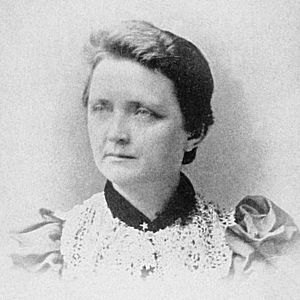Laura Alberta Linton facts for kids
Laura Alberta Linton was an amazing American scientist who lived from 1853 to 1915. She was a talented chemist and later became a physician. She even had a special mineral named after her!
Contents
Early Life and School Days
Laura Alberta Linton was born on April 8, 1853, in Mahoning County, Ohio. She was the oldest child of Joseph and Christina Linton. Her family were Quakers, a religious group.
Her family moved around a bit, farming in Ohio, Pennsylvania, and New Jersey, before finally settling in Wabasha County, Minnesota. Laura went to the Winona Normal School and graduated in 1872. After that, she studied at the University of Minnesota, where she earned a Bachelor of Science degree in Chemistry.
Becoming a Chemist
Discovering Lintonite
While still in college, Laura did some very important work. She analyzed rock samples from the northern shore of Lake Superior. Her professors, Stephen Farnum Peckham and Christopher W. Hall, had collected these samples.
The mineral looked a bit like another one called thomsonite. But Laura's careful analysis showed it had unique features, like its crystal shape and color. Because of her "patient effort and skill," her professors decided it was a new type of mineral. They named it lintonite in her honor!
Working with Petroleum
After college, Laura taught high school in Lake City, Minnesota for two years. Then, she moved to Providence, Rhode Island. There, she helped Professor Peckham with a big report about petroleum (oil) for the 1880 United States Census. Peckham thanked her in his report, saying she helped with many translations and illustrations.
Teaching and Research
In 1882, Laura studied chemistry at the Massachusetts Institute of Technology for a year. She didn't finish a graduate degree there. Instead, she became a professor of Natural Science at Lombard University in Galesburg, Illinois. She taught there for one year before returning to Minneapolis.
For the next ten years, Laura was the head of the science department at Minneapolis Central High School in Minneapolis, Minnesota. She was a dedicated teacher!
Around 1894, Laura went back to chemistry research. She focused on analyzing asphaltum, a sticky, black substance used for roads. She got samples from Professor Peckham. In 1895–1896, she studied at the University of Michigan.
Her work on asphaltum was so good that it was published in two important papers by the American Chemical Society. People recognized her for her careful analysis, clear writing, and the commercial importance of her research. She also co-wrote a paper with Peckham about Trinidad pitch, which was used in a major lawsuit.
Changing to Medicine
Becoming a Doctor
After her successful chemistry career, Laura decided to become a doctor. We don't know exactly why she changed fields. Maybe it was a family influence, as her brother, Thomas Linton, and her sister, Sarah Linton Phelps, were both doctors.
From 1895 to 1900, Laura worked as an assistant in physiology and chemistry at the University of Minnesota. She earned her M.D. (Medical Doctor) degree from the university in 1900.
Helping Patients at Rochester State Hospital
Right after graduating, Laura started working at Rochester State Hospital. She took over for her sister Sarah, who was not well. Laura worked at the hospital for the last fifteen years of her life.
She made two big differences at the hospital:
- She taught nurses about healthy eating and dietary principles.
- She started a special program for mentally ill female patients. They were allowed to do needlework and handicrafts. This was one of the very first hospital programs to use occupational therapy, which helps people recover through meaningful activities.
Laura was also a member of important scientific groups like the American Association for the Advancement of Science and the Association for the Advancement of Women.
Later Life and Legacy
Laura Alberta Linton passed away on April 1, 1915, in Rochester, Minnesota. Her work as both a chemist and a physician left a lasting impact, from discovering a new mineral to pioneering occupational therapy in hospitals.
Selected publications
See also
 In Spanish: Laura Alberta Linton para niños
In Spanish: Laura Alberta Linton para niños


